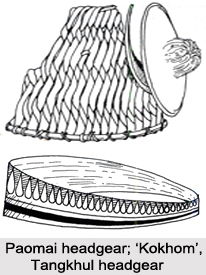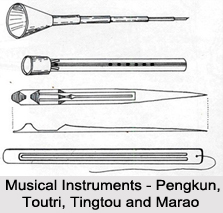 Mongoloid Culture is the culture of cane and bamboo and thus, naturally, there is a touch of cane and bamboo in all walks of the lives of people of Manipur. Ornaments bring out an expression of joy in every man and woman, particularly during festive occasions. Cane and bamboo again play a prominent role in the case of ornaments.
Mongoloid Culture is the culture of cane and bamboo and thus, naturally, there is a touch of cane and bamboo in all walks of the lives of people of Manipur. Ornaments bring out an expression of joy in every man and woman, particularly during festive occasions. Cane and bamboo again play a prominent role in the case of ornaments.
During festivities, when people come out to participate in community dance, etc., tribal folks decorate their head and ears with a variety of headgears and ornaments, made of cheap and readily available material. As much as the several tribes differ from one another in festive and in habitat, so do their headgears and ornaments. And again, there are distinct differences between the headgears worn by men and those donned by women of a particular tribe. Bamboo and cane splits are compulsory components for structuring the basic forms of the headgears and ornaments. Tribal men folk use a headgear woven with cane splits, made to fit neatly like a cap and is put on when they are dancing. Kokhom is a beautiful bamboo headgear donned by the equally beautiful Tangkhul girls while dancing. It is highly decorative. The Paomai men use a conical and sturdy cane headgear which is thickly woven. It is elegant and protects the head. The Kharam tribal belt folks embellish their ears with flowers made of bamboo. The tribal people also decorate their arms and legs with wristlets called Khudangyai, and anklets known as Khubomyai. Both the Khudangyai and the Khubomyai are made of cane. Besides being a form of decorative ornaments, the Khudangyai and the Khubomyai serve as protective gear in battles, fights etc. The Mao, the Maram and the Paomai tribes used dyed cane leggings from ankle up to the knee during the dances. The Mizo, the Thadou and other Kuki tribes, particularly of the Churachandrapur district, make a beautiful hat woven from separated fine fibres of cane, unique in every fashion.
Cane and bamboo have also been used in Manipur to make musical instruments, which make their songs and dance more appealing. The tribal people inhabiting the hills use a wide range of wind musical instruments made from bamboo. These are mainly played with the mouth. During yesteryears, the Meitheis made use of bamboo and bamboo roots to make the Pena, an indigenous musical instrument. The Lamgang tribe contrive cut tubes of a small variety of bamboo, to make a flute like wind musical instrument called Puleh. This instrument has 4 to 7 holes. The Maring tribe too uses a similar musical instrument called Toutri. The Koms, on the other hand, call such instrument Theibe. The Thadou tribe folks cut 3 tubes of different lengths from the same bamboo stem, and the tubes and separately blown with the mouth to produce different musical notes. The Thadous refer to such musical instruments as Theiphit. The Lamgang tribe uses a peculiar wind instrument called Relru, which is a one metre long hollow bamboo tube with an attached projection in the middle, through which one blows with the mouth to produce musical notes.
Almost all the tribal belts in Manipur use a musical instrument constituting 4 to 5 bamboo tubes of uneven sizes that are joined together, the smaller tubes being partly inserted into the bigger ones. The instrument is played like a bugle. The Lamgang tribe makes use of both hard and outer layer or skin of the bamboo and the pulpy inner layer to make a musical instrument. The necessary length of both the layers is 30 centimetres. Many of the tribal groups also configure fine bamboo splits or Paya, to make an interesting musical instrument that is played with the mouth. The Paya must be 15 centimetres long and 1.5 centimetres broad. The Mao tribe calls it Khetsh, while it is referred to as Marao by the Tangkhul Nagas of Manipur.
Related Articles:
Cane and Bamboo Products of Manipur
Manipur
Meithei Language
Crafts of Manipur
Bamboo and Cane Crafts of Manipur
Bamboo Crafts in India
Cane Craft
Weaving and Dyeing Craft



















